A near-total lunar eclipse will be widely visible across North America on the night of November 18–19. Dress warmly and go for it!
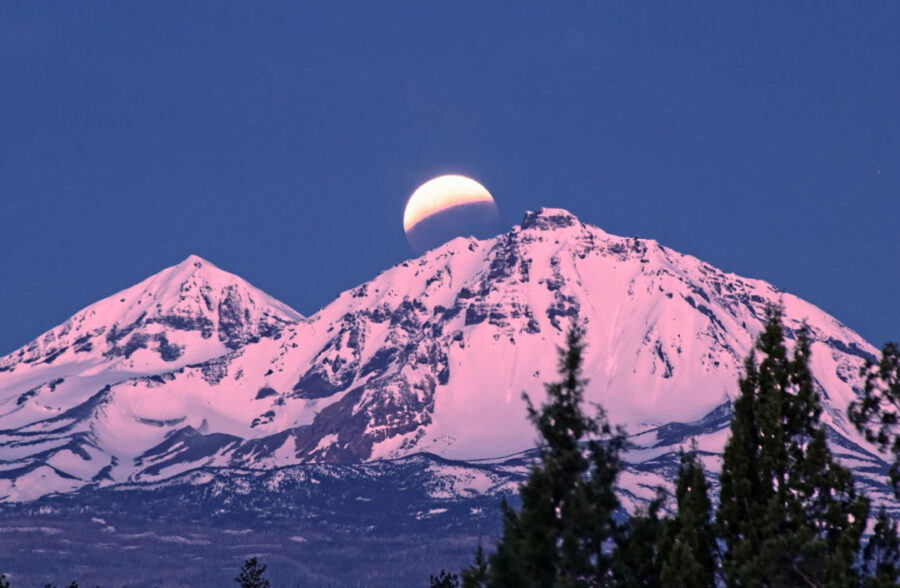
Alan Gillespie
The deep partial lunar eclipse on the night of November 18–19 should be spectacular. With 97% of the full Beaver Moon in Earth's shadow at mid-eclipse, we'll witness nearly all the good stuff associated with a total eclipse, including the Moon's radical color change from bone white to tangerine. The only thing we won't see is totality. At maximum eclipse, a silvery 0.7 arcminutes of the Moon's southern limb will extend beyond the umbra.
Lucky for us, full Moon occurs 1.7 days before apogee, when the Moon is farthest from Earth in its elliptical orbit. This shrinks its apparent size, so more of it squeezes inside the umbra than normal. The increased distance also means the Moon moves more slowly in its orbit. In fact, this will be the longest partial lunar eclipse since Feb. 18, 1440 — more than 6 hours from start to finish. And we won't get a longer one until Feb. 8, 2669!
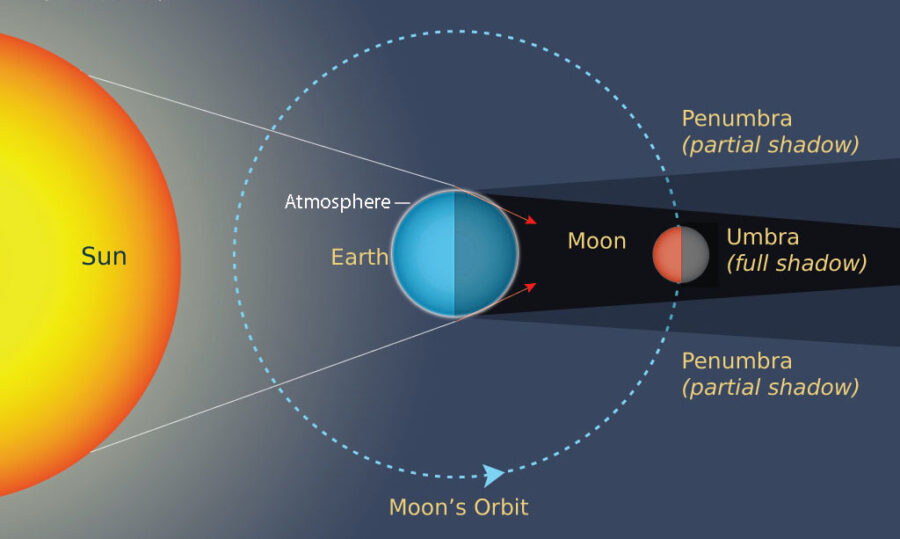
Starry Night with additions by Bob King
Sky & Telescope
As is true with all lunar eclipses, half the planet can see one or more aspects of the event — anywhere the Moon is above the horizon. This includes the Americas, northern Europe, eastern Asia, Australia, and the Pacific. Virtually the entire show will be visible across North America. Click here for a coverage map. Two weeks and a half-orbit later on December 4th, the Moon will totally eclipse the Sun from the Southern Ocean and Antarctica.
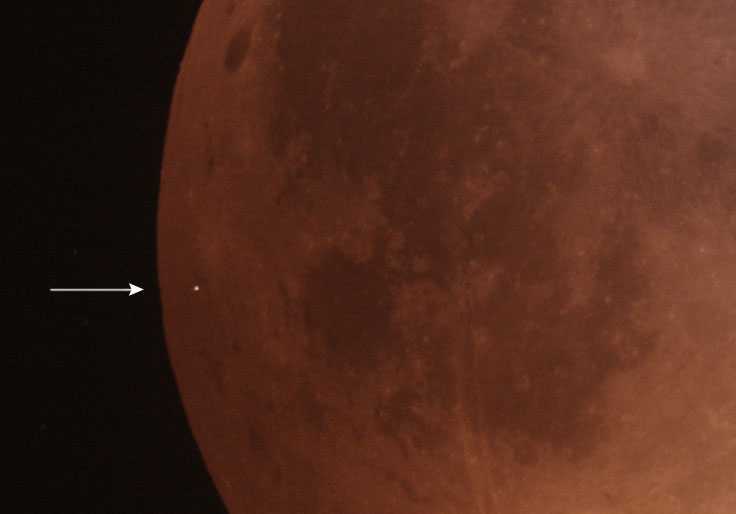
Christian Fröschlin
Sky & Telescope
Coincidentally, the eclipse happens very close to the maximum of the Leonid meteor shower which peaks on November 17–18, raising the possibility of seeing or recording a Leonid meteor impact on the darkened Moon. While it's an off-year for the shower with a maximum of only about 15 meteors per hour, be alert to the possibility. If you have a second telescope to shoot video for a half-hour or so around mid-eclipse, it may be worth a shot (see, e.g., the Pro-Am Conjunction column in the November issue of Sky & Telescope). Several observers recorded a split-second meteor impact flash during the total eclipse of January 20, 2019.
For other ways amateurs can contribute valuable observations during the eclipse check out Useful Projects for a Lunar Eclipse by Sky & Telescope's Roger Sinnott.
Eclipse phases by time zone
| November 18–19, 2021 | AST | EST | CST | MST | PST | AKST | HST |
| Penumbra first visible? | 2:45 a.m. | 1:45 a.m. | 12:45 a.m. | 11:45 p.m. | 10:45 p.m. | 9:45 p.m. | 8:45 p.m. |
| Partial eclipse begins | 3:18 a.m. | 2:18 a.m. | 1:18 a.m. | 12:18 a.m. | 11:18 p.m. | 10:18 p.m. | 9:18 p.m. |
| Mid-eclipse | 5:03 a.m. | 4:03 a.m. | 3:03 a.m. | 2:03 a.m. | 1:03 a.m. | 12:03 a.m. | 11:03 p.m. |
| Partial eclipse ends | 6:47 a.m. | 5:47 a.m. | 4:47 a.m. | 3:47 a.m. | 2:47 a.m. | 1:47 a.m. | 12:47 a.m. |
| Penumbra last visible? | ----- | 6:35 a.m. | 5:35 a.m. | 4:35 a.m. | 3:35 a.m. | 2:35 a.m. | 1:35 a.m. |
November is often cloudy and cold. For big events like eclipses I keep track of the weather using GOES-East satellite imagery, which provides excellent coverage of the eastern two-thirds of the U.S., southern Canada, and Central America. There's also a GOES-West version.
When you click either link above it defaults to a visible-wavelength image. For night use you'll need infrared imagery to see and track clouds. Click the Choose bar drop-down menu and select Channel 7. Clicking anywhere on the map will pop up an enlarged view of that region. When you back-arrow to wide-view mode, controls let you increase image size or create an animated loop to discern trends in cloud movement.
Eclipse photo guide
| ISO 800 | f/2.8 | f/4 | f/5.6 | f/8 |
| No eclipse | ------ | ------ | ------ | 1/4000 |
| Penumbral eclipse | ------ | ------ | 1/4000 | 1/2000 |
| Partial eclipse (30% covered) | ------ | 1/4000 | 1/2000 | 1/1000 |
| Partial eclipse (60% covered) | 1/4000 | 1/2000 | 1/1000 | 1/500 |
| Partial eclipse (90% covered) | 1/1000 | 1/500 | 1/250 | 1/125 |
| Total eclipse (bright) | 1/15 | 1/8 | 1/4 | 1/2 |
| Total eclipse (dark) | 1 sec. | 2 sec. | 4 sec. | 8 sec. |
| Total eclipse (very dark) | 4 sec. | 8 sec. | 15 sec. | 30 sec. |
Bob King
The Weather Network also offers a handy, interactive cloud viewer or you can check the U.S. 7-Day Cloud Cover Forecast. If you can't escape bad weather, Gianluca Masi will live stream the show on his Virtual Telescope site on November 19th starting at 7:00 UT (2 a.m. EST). Griffith Observatory and Lowell Observatory are also offering live views.
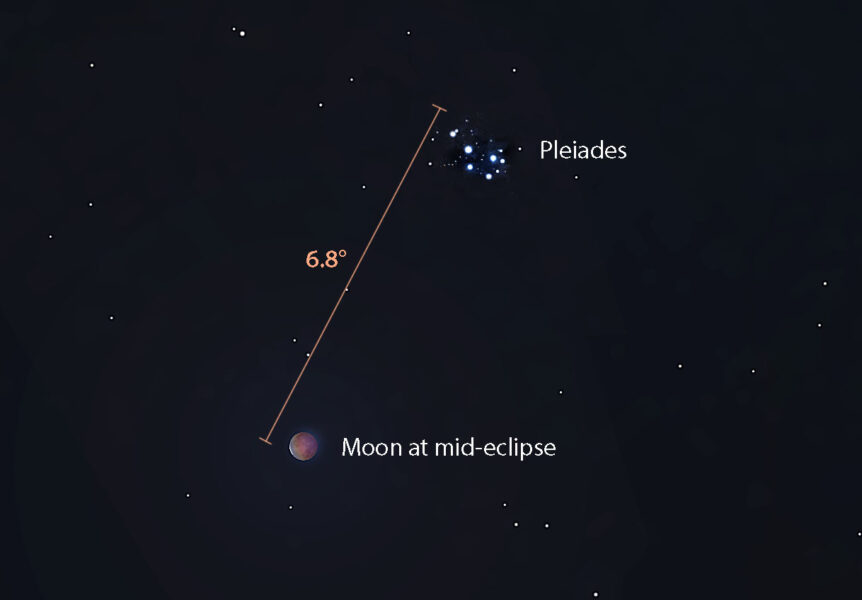
Bob King
November's near-totally eclipsed Moon will accompany the Pleiades, one of the brightest and prettiest star clusters in the heavens. At mid-eclipse, just 6.5° separate the two, making for an excellent picture opportunity. Try photographing the scene when the sky is darkest around mid-eclipse. Almost any lens will do depending on what, if any, foreground you include. I recommend a 100- to 200-mm telephoto to capture a bit more detail. With a full-frame sensor, a 100-mm lens has a field of view of 20.4° × 13.7°; a 200-mm lens, 10.3° × 6.9°.
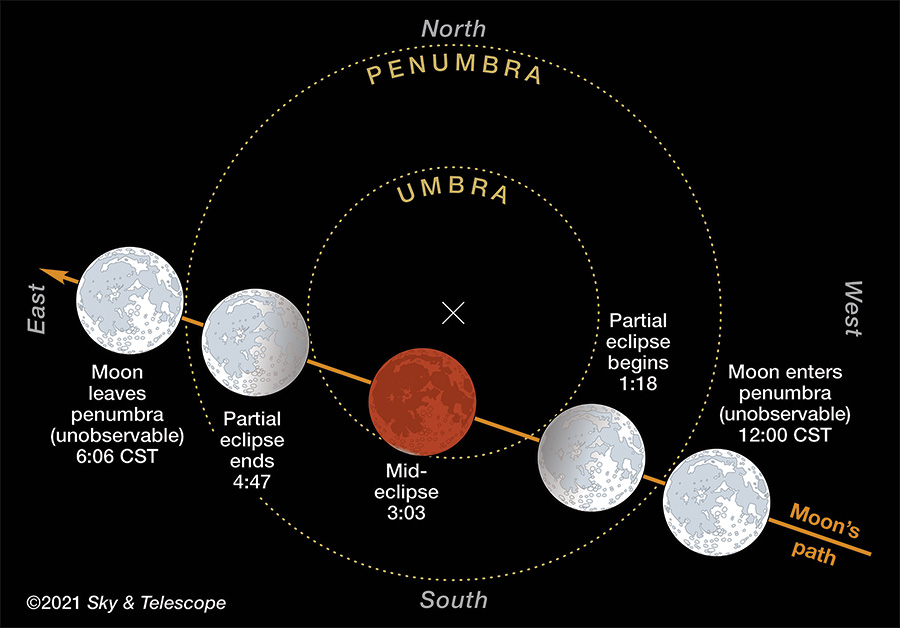
Gregg Dinderman, Sky & Telescope
Slipping into Shadowland
I plan to share the eclipse with a friend. We'll be observing with everything we've got: naked eyeballs, binoculars, and telescopes. Each offers a unique perspective, and a lunar eclipse is long enough to employ them all. The naked eye works best in experiencing the transformation of the night from harsh moonlight and star-poor skies to dark quietude under the cover of umbral darkness. This has always been one of my favorite aspects of lunar eclipses. Without sunlight the Moon looks small and less substantial, as if robbed of its superpowers.
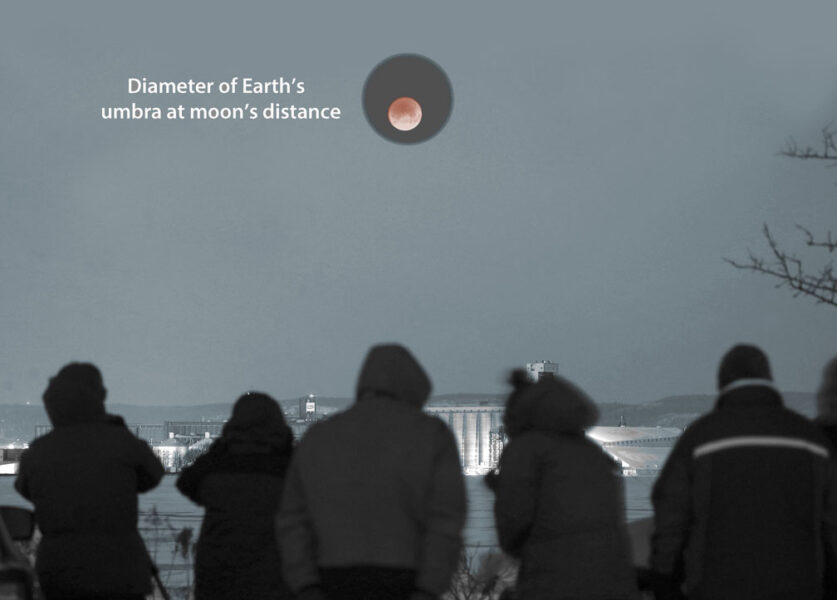
Bob King
Binoculars enhance and intensify the Moon's color transformation and add a third dimension, giving the ruddy globe the appearance of being suspended among the stars. A telescope clearly shows the shadow's blurry edge, softened by Earth's atmosphere, as well as other more subtle colors like smoky yellows, shades of tea, and even pale blue (caused by absorption of red light by the ozone layer). It's also great fun to watch the major craters succumb in succession to the encroaching shadow. Imagine the scene from the Moon, standing atop Tycho's central peak watching the Earth slowly cover the Sun. Wow!
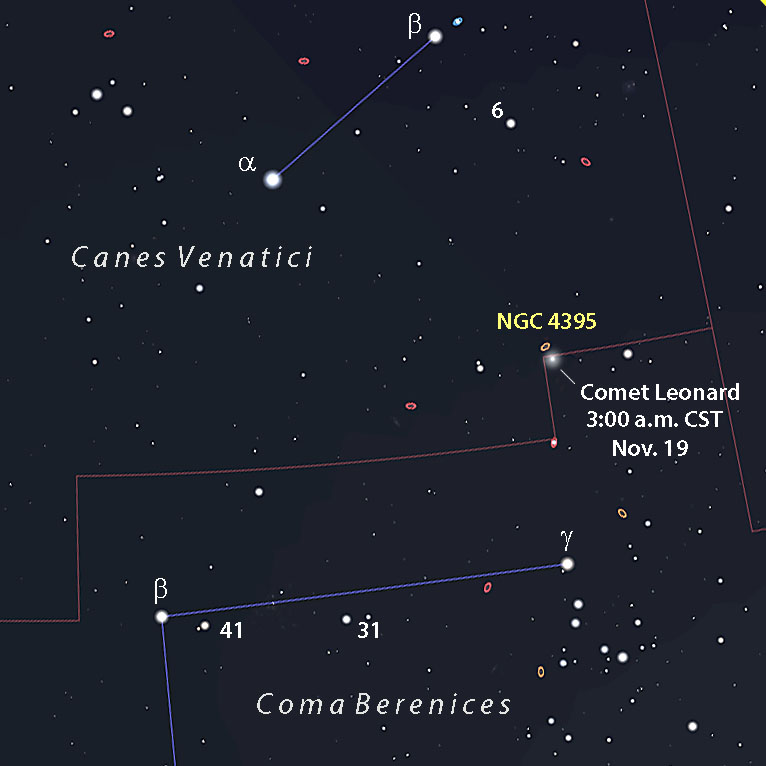
Stellarium
Consider a side trip to Comet Leonard at mid-eclipse for a special surprise. That morning, the comet will appear about 20′ south-southwest of the 10th-magnitude galaxy NGC 4395 and will glow around magnitude 9. You might even glimpse it in 50-mm binoculars. But not for long! The Moon has places to go and soon enough departs the valley of shadow to flood the sky with light again.
The slow rhythm of a lunar eclipse provides an opportunity to stop, catch our breath, and fall in line with the three most significant cosmic bodies in our life.
 24
24











Comments
Rod
November 11, 2021 at 7:49 am
Thanks for this report and tables. I used Stellarium and Starry Night set to 19-Nov at 0800 UT for my location (Maryland). A number of sights will be up. M44, M67, M42, M35 in Gemini, M41 in Canis Major, along with Ceres traveling in Taurus. Weather and clouds permitting, I plan to be out near 0200 EST using my 90-mm refractor telescope and 10x50 binoculars for viewing.
You must be logged in to post a comment.
Bob KingPost Author
November 12, 2021 at 11:12 am
You're welcome, Rod. Yes, there's lots to see when the Moon hides in shadow. I plan to steal views of Comets Leonard and 67P then return to the eclipse. I hope you have clear skies.
You must be logged in to post a comment.
misha17
November 12, 2021 at 6:11 pm
CBS News is reporting that this will be the longest partial lunar eclipse this century.
https://www.cbsnews.com/news/lunar-eclipse-frost-moon-how-to-watch-november-18-19-2021/
It follows May's total lunar eclipse, which might have been the shortest lunar eclipse this century with only 15 mins of totality*.
* The lunar eclipse on April 4th 2015, was supposed to be total for only 5 minutes, but it passed so close to the edge of the umbra that it may have only been a ~very~ deep partial lunar eclipse. if the 2015 eclipse was really only a partial eclipse, its partial phase lasted 3 hr 29 mins, about as long as next week's eclipse. The 2015 may have lasted a few seconds longer than next week's eclipse, but the exact edge of the umbra depends on conditions in the earth's atmosphere at the time of the eclipse (part of the reason why the 2015 eclipse might not have completely entered the umbra).
You must be logged in to post a comment.
misha17
November 12, 2021 at 6:14 pm
clarification: May's eclipse may have been the shortest ~total~ lunar eclipse this century, not the necessarily the shortest umbral eclipse (partial duration plus totality duration)
You must be logged in to post a comment.
Alex Amorim
November 18, 2021 at 7:17 am
In fact, according to Helio Vital's calculations and analysis of observations, that April 2015 eclipse had a umbral magnitude of 0.9996 (very deep partial eclipse and not total eclipse) and its umbral duration was 3 hours and 29.4 minutes.
More information in the website: http://geocities.ws/lunissolar2003/2015_Apr4_Helios_Analysis.htm
You must be logged in to post a comment.
Markhl
November 12, 2021 at 6:32 pm
Thanks! I also like using the Clear Sky Chart at http://www.cleardarksky.com/csk/ to forecast clear and dark skies for locations in Canada, USA, and parts of Mexico.
You must be logged in to post a comment.
GaryN
November 18, 2021 at 7:58 pm
I think the de-facto service for getting astronomy data from the Canadian Meteorological Centre is Astrospheric (https://www.astrospheric.com). Even some folks I've chatted with at the CMC have switched to Astrospheric from Clear Sky Chart.
You must be logged in to post a comment.
Kenneth Schroeder
November 15, 2021 at 2:53 pm
Nice article on the lunar eclipse. I definitely recommend watching for impacts. I was really lucky and saw the 2019 impact in real-time, visually, using only a pair of Canon binoculars. The flash was very short but clearly visible. I believe that I would have been able to see the flash naked-eye if I had been looking without binoculars.
Ken Schroeder
Auburn, WA
You must be logged in to post a comment.
Bob KingPost Author
November 16, 2021 at 12:23 am
Hi Kenneth,
Thanks for sharing your experience. I'll be watching and hope others will, too.
You must be logged in to post a comment.
Anthony Barreiro
November 15, 2021 at 6:20 pm
With all the new landers going to the Moon, how about putting one on the nearside where the Earth is always above the horizon, with a couple of video cameras showing a wide field view of the Earth bobbing up and down above the horizon over the course of a lunar month, and a tracking zoomed in view of the Earth. Put the live video feed up on the internet. It would be interesting to see the Earth from the Moon at any time, especially so during lunar and solar eclipses. If there's not enough scientific or political value in such a mission for NASA to cover the cost, maybe Jeff Bezos or Elon Musk could write a check.
Unfortunately the weather forecast here in San Francisco does not look good for the eclipse: mostly cloudy with a chance of rain (if we're going to have clouds anyway, we could use the rain!). The good news is that the Moon will be very high in the sky from the first contact of the Moon with Earth's umbra until after maximum eclipse, so I can just step out into the back yard to have a peek, no need for a special trip.
You must be logged in to post a comment.
Bob KingPost Author
November 16, 2021 at 12:24 am
Dear Anthony,
Such a great idea. You know I feel exactly the same about this.
You must be logged in to post a comment.
Mike Hanafin
November 18, 2021 at 1:31 pm
I suspect the fact this is *so close* to total, will make it even more interesting, as the moon grazes the edge of the shadow, and the "lit" sliver rotates around the moon's edge...likely looks similar to total eclipse that doesn't go deep into shadow. Looks like I'll have to rely on observer photos and videos, as Vancouver is rainy and cloudy. Unless we get lucky with a break.
You must be logged in to post a comment.
misha17
November 18, 2021 at 10:32 pm
Some stream links:
Virtual Telescope Network:
https://www.youtube.com/watch?v=c_SaZ2bitws
TimeAndDate:
https://www.youtube.com/watch?v=80uMSAWogjo
Hawaiʻi (3 streams on the page)
https://sites.google.com/view/lunareclipse?fbclid=IwAR2M1FaAbpsKmi4V_jsyTnJlWtypjdTZcb-O_qbPCRAWeaPBmyogBRUemaM
* ManitobaMuseum tweeted several linkS:
- Science North in Sudbury, Ontario - https://timeanddate.com/live/eclipse-lunar-2021-november-19
- High Point Scientific - https://youtube.com/watch?v=sBGU8WUrfMk\
- Astronomy by the Bay - live-streaming from the east (Canada) coast: https://facebook.com/events/s/the-partial-lunar-eclipse/263123799113228/
- TELUS World of Science Edmonton (via Zoom) - https://us02web.zoom.us/j/83952111630
- Lowell Observatory in Flagstaff, AZ - https://fb.me/e/1aQG7MFhX
You must be logged in to post a comment.
Rod
November 19, 2021 at 6:24 am
Okay Bob King et al. I was able to enjoy much of the partial lunar eclipse this morning. Here is my notes from observation log. [Observed 0230-0445 EST/0730-0945 UT. Full Moon 19-Nov-2021 0857 UT. Deep partial lunar eclipse this morning with the Moon in Taurus. This was a lovely early morning celestial event to enjoy using my telescope and 10x50 binoculars. At 31x, I could see Earth’s shadow moving across the Moon and by 0325 EST/0825 UT, Tycho crater covered by the shadow. Tinge of orange color across the Moon was visible. Some altocumulus clouds moved by after 0330 until almost 0400 EST and caused viewing problems. Skies cleared again near 0400 EST/0900 UT. I used 32-mm plossl eyepiece with true FOV about 96 arcminutes at 31x views. Virtual Moon Atlas reports the Moon’s angular size 29.80 arcminutes. Some stars near the lunar limb were distinct and visible in the eyepiece. They were closer than 15 arcminutes, some 5 or 7 arcminutes or closer. HIP16737, HIP16674, TYC12139-679-1, and HIP16811. HIP16811 Stellarium shows apparent magnitude 8.70. By 0439 EST/0939 UT, Tycho crater back in sunlight again as the Earth’s shadow receded from the Moon. While I viewed, temperature 5C and winds NW 14 knots gusting to 19 knots. I did not observe the entire partial eclipse, the Moon was getting lower in elevation ready to pass behind some trees nearby. However, this was a very enjoyable partial lunar eclipse to view using my 90-mm refractor telescope and 10x50 binoculars. The Moon in Taurus during a deep, partial lunar eclipse with the Pleaides nearby in angular separation was an excellent sight.]
You must be logged in to post a comment.
bob kelly
November 19, 2021 at 8:06 am
Hi, Rod,
Thanks for that report - that says it all! Much the same here near NYC - I observed from 3:40am to 5am, the cold front that brought rain earlier in the night cleared out the rain and clouds and gave us a wonderfully clear sky! Photos at the blog https://bkellysky2.wordpress.com/2021/11/19/2021-11-19-an-almost-total-lunar-eclipse/
You must be logged in to post a comment.
bob kelly
November 19, 2021 at 7:57 am
Photos of the eclipse at https://bkellysky2.wordpress.com/2021/11/19/2021-11-19-an-almost-total-lunar-eclipse/
You must be logged in to post a comment.
Rod
November 19, 2021 at 9:13 am
bob kelly, thanks for the pictures at the links. Glad you took some photos and showed the Moon along with the Pleiades. That was a lovely sight. I was out viewing in Maryland along the Patuxent river farms, more rural areas, open spaces, horses, alpacas, chickens, some bee farms, and no street lights 🙂
You must be logged in to post a comment.
bob kelly
November 19, 2021 at 1:55 pm
Hi, Rod, it was so different to see the Pleiades and Hyades with a Full Moon, albeit dimmed!
You must be logged in to post a comment.
Mike Hanafin
November 19, 2021 at 11:40 am
Thanks for link to your blog and photos. And everything astronomy in general. Very fortunate the clouds parted in Vancouver around midnight, and was able to see over an hour--including mid-eclipse. Question: do partial lunar eclipses (even 97%) get brightness ratings? The shadowed 97% was very, very bright (orangeish, but quite bright for naked eye, and my 10x50 binoculars), one of the brightest I've ever seen (and I've seen a lot). Like a 4 to 4.5 Danjon scale rating? Thoughts? Your estimate? Glad you could see it on the East coast
You must be logged in to post a comment.
bob kelly
November 19, 2021 at 2:57 pm
One rating I saw was at Joe Rao's facebook page: https://www.facebook.com/JoeRaoWeather
You must be logged in to post a comment.
Mike Hanafin
November 19, 2021 at 3:31 pm
Thanks! excellent, and matches my observations
It was exceptional.
You must be logged in to post a comment.
Mike Hanafin
November 19, 2021 at 3:29 pm
Doh! I meant 3-3.5. since the scale only goes to 4!
You must be logged in to post a comment.
Joe Stieber
November 19, 2021 at 4:26 pm
I went to the relatively dark Pines here in southern New Jersey to watch the eclipse because I wanted to see the stars pop out as the sky darkened along with the moon. The effect is dampened by suburban light pollution at home. A cold front blew through overnight, and luckily, about an hour before maximum eclipse at 4:03 am EST, the sky cleared completely. I had a terrific view of the eclipsed moon, mostly a deep orange color near maximum (very reminiscent of a total eclipse), and for a while, a star-studded sky. I was able to see M35, M41, and M47 with unaided eyes around maximum eclipse.
However, topping the list for me was my first sighting of comet C/2021 A1 (Leonard), which I picked up up through gaps in the clouds at 2:50 am with my 15x56 binoculars (more than an hour before maximum eclipse). Shortly after, I confirmed it with my 88 mm apo spotting scope at 25 to 60x, with which it showed a hint of a tail extending vertically. Looks like Leonard is on track for a good show in mid-December.
I also took the opportunity to spot (1) Ceres with the 15x56s and the 88 mm scope. I've been watching it march across the Hyades since November 3 when it passed within seven arc minutes of Aldebaran.
You must be logged in to post a comment.
Rod
November 19, 2021 at 9:16 pm
Great viewing report Joe Stieber. I was thinking about viewing Ceres in Taurus during the eclipse but did track it down tonight after 1930 EST and viewed with my 90-mm refractor at 31x. Here is to clear skies 🙂
You must be logged in to post a comment.
You must be logged in to post a comment.